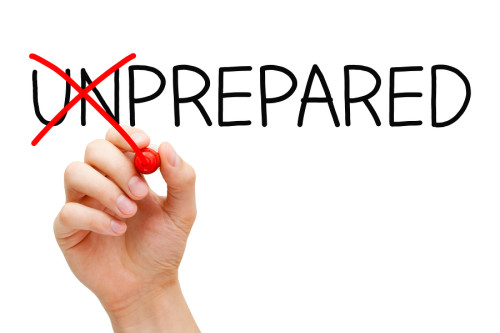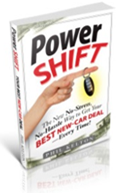 From the first time a customer makes contact until a sale is made, the typical new-car sale often takes many months. That time translates into overhead cost for the dealer—facilities, utilities, employee salaries, and floor-plan financing (loans to dealers for cars on the lot). The faster a sale is made, the lower the overhead cost-per-car and the greater the dealer profit—or perhaps the larger your price reduction.
From the first time a customer makes contact until a sale is made, the typical new-car sale often takes many months. That time translates into overhead cost for the dealer—facilities, utilities, employee salaries, and floor-plan financing (loans to dealers for cars on the lot). The faster a sale is made, the lower the overhead cost-per-car and the greater the dealer profit—or perhaps the larger your price reduction.
So the first step in successful Power Shift car buying is to be car-buying ready—prepared for an immediate purchase—when you make your first contact with the car dealer. You’ll take specific steps to make it obvious that you are a hot prospect, ready for an immediate sale.
Car-Buying Ready
The following steps will prepare you to make an immediate purchase and position yourself for your best new-car deal.
- Select your car, including trim and options
- Prepare the manufacturer’s description for your selected car
- Prepare an out-the-door (OTD) reference price
- Obtain cash or preapproved financing
- Choose your trade-in approach, if applicable
- Understand the dealer finance and insurance (F&I) department
1. Selecting Your New Car
With over a thousand new-car models and trims available, new-car buyers can usually find the kind of car that suits them best. Preferences range from high gas mileage to high performance, from new technology to top safety ratings. No matter your personal preferences, make sure you assess your potential selection for affordability and acceptable safety and reliability. You might also consider the yearly cost of ownership, if that is an important factor for you. Edmunds.com provides a Total Cost of Ownership (TCO) assessment that you can use to compare various models of interest.
Once you’ve selected the candidate or set of candidates, look through online pictures and videos (Youtube is a great video source), get up-close and personal at an auto show, and always test drive your selection before you buy it.
2. Preparing the Manufacturer’s Description
This is a key step, ensuring that your selected new car can be purchased from any new-car dealership. Fortunately, it’s easy to accomplish. Simply go to the manufacturer’s website and use the build tool. Stop when you reach the summary page, before you request a quote. Then prepare a description of the car you want using the manufacturer and dealer’s language.
For a 2014 Nissan Altima, it might look something like the example below:
2014 Nissan Altima Sedan 2.5 SV with Pearl White exterior, Charcoal Cloth interior, and the following options:
- Convenience package
- Carpeted floor and trunk mats
3. Prepare an Out-the-Door Reference Price
This is a reference price that you prepare for your own information; never share it with the car dealer. It serves as a valuable resource for assessing the quality of your dealer bottom-line quote—both as a checklist and a price comparison. Edmunds is a good source for free pricing information. Consumer Reports offers a paid pricing report service.
The OTD price is based on published pricing information; it starts with the invoice base and option prices and includes destination charge, documentation fees (if regulated in your state), state title and registration fees, and state sales tax, if applicable. Reduce the reference price for dealer holdback and dealer cash incentives, if applicable to your model.
4. Obtain Cash or Preapproved Financing
If you’re not careful, dealership new-car financing can cost you. Dealers obtain wholesale financing from their business partners and add a financing reserve, or profit, to a wholesale interest rate. This additional interest rate can be as much as an additional 2 to 2.5 percent and can result in financing offers that maximize dealer profit rather than provide your best interest rate. You’ll have a better outcome if you pay with cash or obtain preapproved financing from your bank or credit union before you arrive at the dealership. You can then consider dealer financing if it is a good deal, but you won’t be dependent on the dealer’s offer.
5. Choose your Trade-in Approach
The best way to get the most money for your current car is to sell it at a different place on a different day. Dealers often offset a good new-car price with a poor trade-in offer to increase their profit for the total deal. You’ll be better able to compare dealer quotes if you keep your trade-in separate.
There are many options for selling your current car, including private party sales, dealer competition, guaranteed easy quotes (Autonation Direct or Carmax), or donation. The bottom line is that the harder you work at it, the greater the likely cash value.
6. Understand the Finance and Insurance (F&I) Office
This step will be the topic of a more extensive future post. However, for now, you should be aware that the F&I office is the most profitable area of the new-car business, with profit margins of 100 percent or more. You can easily spend another $2,000 to $3,000 after you’ve settled on the price of your new car.
The bottom line is that anything of value can be purchased after you bring your car home. Just say no to add-ons in the F&I office!
Ideal for Well-Run Dealerships
When you are prepared for an immediate purchase, well-run dealerships with lower overhead costs will be better able to make more competitive offers. These dealers will shine in the presence of a hot prospect. You’ll obtain that great deal you’re seeking—simply because you’re car-buying ready before you make your first contact.

